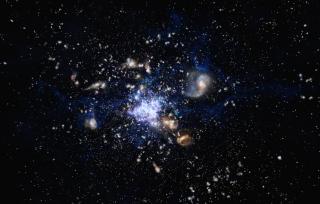Bibcode
Dannerbauer, H.; Lehnert, M. D.; Emonts, B.; Ziegler, B.; Altieri, B.; De Breuck, C.; Hatch, N.; Kodama, T.; Koyama, Y.; Kurk, J. D.; Matiz, T.; Miley, G.; Narayanan, D.; Norris, R. P.; Overzier, R.; Röttgering, H. J. A.; Sargent, M.; Seymour, N.; Tanaka, M.; Valtchanov, I.; Wylezalek, D.
Referencia bibliográfica
Astronomy and Astrophysics, Volume 608, id.A48, 15 pp.
Fecha de publicación:
12
2017
Revista
Número de citas
80
Número de citas referidas
76
Descripción
It is not yet known if the properties of molecular gas in distant
protocluster galaxies are significantly affected by their environment as
galaxies are in local clusters. Through a deep, 64 h of effective
on-source integration with the Australian Telescope Compact Array
(ATCA), we discovered a massive, Mmol = 2.0 ±
0.2× 1011 M⊙, extended, 40 kpc,
CO(1-0)-emitting disk in the protocluster surrounding the radio galaxy,
MRC 1138-262. The galaxy, at zCO = 2.1478, is a clumpy,
massive disk galaxy, M∗ 5 × 1011
M⊙, which lies 250 kpc in projection from MRC 1138-262
and is a known Hα emitter, named HAE229. This source has a
molecular gas fraction of 30%. The CO emission has a kinematic gradient
along its major axis, centered on the highest surface brightness
rest-frame optical emission, consistent with HAE229 being a rotating
disk. Surprisingly, a significant fraction of the CO emission lies
outside of the UV/optical emission. In spite of this, HAE229 follows the
same relation between star-formation rate and molecular gas mass as
normal field galaxies. HAE229 is the first CO(1-0) detection of an
ordinary, star-forming galaxy in a protocluster. We compare a sample of
cluster members at z > 0.4 thatare detected in low-order CO
transitions, with a similar sample of sources drawn from the field. We
confirm findings that the CO-luminosity and full-width at half maximum
are correlated in starbursts and show that this relation is valid for
normal high-z galaxies as well as for those in overdensities. We do not
find a clear dichotomy in the integrated Schmidt-Kennicutt relation for
protocluster and field galaxies. Our results suggest that environment
does not have an impact on the "star-formation efficiency" or the
molecular gas content of high-redshift galaxies. Not finding any
environmental dependence in these characteristics, especially for such
an extended CO disk, suggests that environmentally-specific processes
such as ram pressure stripping do not operate efficiently in
(proto)clusters.
The reduced datacube (FITS file) is only available at the CDS via
anonymous ftp to http://cdsarc.u-strasbg.fr (http://130.79.128.5) or via http://cdsarc.u-strasbg.fr/viz-bin/qcat?J/A+A/608/A48
Proyectos relacionados

Gas Molecular y Polvo en Galacias através del Tiempo Cósmico
Dos cuestiones fundamentales en la Astrofísica son la conversión de gas molecuar en estrellas y cómo este proceso físico depende del entorno en todas las escalas, desde sistemas planetarios, cúmulos estelares, galaxias hasta cúmulos de galaxias. El objectivo principal de este proyecto es el de estudiar la formación y evolución de galaxias a partir
Helmut
Dannerbauer